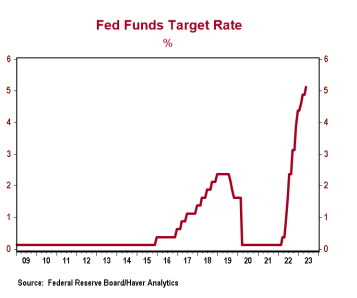The Fed raised short-term interest rates by another quarter percentage point today to a range of 5.00 – 5.25%, just like most analysts and investors expected. In addition, policymakers made changes to its official statement that hint that this rate hike might be the last of the cycle.
In particular, the Federal Reserve removed language from the previous statement that it “anticipates that some additional policy firming may be appropriate” and a reference to “future increases” in the target range. Now the emphasis in the statement is that further rate hikes “may be appropriate” with no reference to “future increases” in the target range. In reaction, the futures market is pricing in no more rate hikes this cycle and for cuts to start in September, with about three or four quarter-point rate cuts by the end of January 2024.
By contrast, we think inflation will remain more elevated than the Fed projects and that the Fed will likely raise rates at least one more time this cycle. In addition, we believe the process for starting rate cuts is further off than the futures market suggests. Chairman Powell himself, at the post-meeting press conference, poured cold water on the prospects of rate cuts, assuming the economy develops as the Fed expects.
Yes, headlines are full of stories about banking turmoil, but the Fed and FDIC have, at least temporarily, ring-fenced traditional banks, guaranteeing deposits in FDIC-insured accounts, potentially no matter how high. This will prevent bank runs, kicking the can down the road for future policymakers to deal with the problem. Meanwhile, although we believe a recession is coming it isn’t here yet.
But investors need to understand that changes in short-term interest rates are not as important as what’s happening to the M2 measure of the money supply. It is M2 that will tell us what the net effects of all the Fed’s policies and the banking situation are. M2 soared more than 40% in the first two years of COVID, but plateaued last year and then started to decline; in the past eight months, M2 is down 4.1%, the steepest drop for any eight-month period since the Great Depression. If this continues through year end, it could generate a deeper recession and more forceful drop in inflation than we anticipate.
One key takeaway from today’s meeting is that the Fed press, once again, failed to ask any questions about either the money supply or how the Fed is funding its operations when it’s running at a prolonged loss, which is an unprecedented situation for the modern Fed. Talk about groupthink! Instead, we get pretty much the same three to five cookie-cutter questions asked several different ways.
The Fed remains all mixed up. The reason it’s mixed up is because in the 2008-09 crisis it abandoned its long tradition of implementing monetary policy through scarce reserves and imposed a new policy based on abundant reserves. They didn’t know where it was heading at the time; now we’re finding out. The turmoil in the markets isn’t over. We remain cautious on equities and think a recession is on the way.
Brian S. Wesbury, Chief Economist
Robert Stein, Deputy Chief Economist
Date: 5/3/2023




